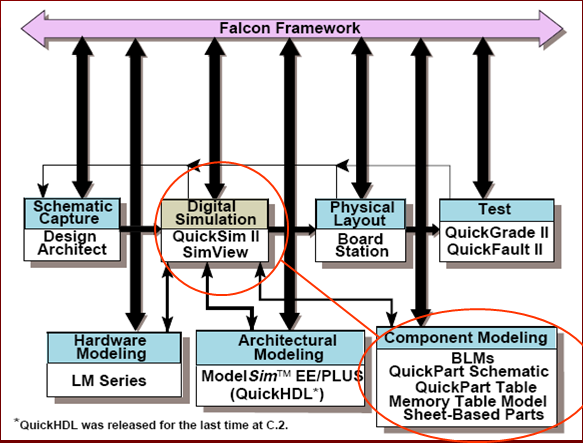 I just upgraded my laptop from Windows Vista to Windows 7 and it got me thinking about Mentor’s Falcon Framework. How are the two even related?
I just upgraded my laptop from Windows Vista to Windows 7 and it got me thinking about Mentor’s Falcon Framework. How are the two even related?
When Microsoft introduced Vista they assumed that the installed base of XP users would be excited to try something new and better. Well, history showed something like only 25% of the installed XP based dared to even try Vista after all of the horror stories about driver incompatibilities, bugs, increased memory usage, slow response, and lack of compelling new features.
When Microsoft figured out that Vista bombed in the marketplace they wisely renamed the successor Windows 7, no mention of that failed “Vista” to be ever spoken of again.
From a technology perspective Windows 7 will look and feel totally familiar to any Vista user. In fact, most all of your Vista drivers and applications will simply work in Windows 7. Marketing named this “Windows 7″ when it feels like Vista that starts a bit faster, and closes quicker. Oh, yes, they did add more eye candy, and some new features. In the next one year of use I will not be more productive than the time it took me to install Windows 7.
Let’s get back to EDA now and talk about Mentor Graphics and the Falcon Framework. This unified framework was supposed to make all of my EDA point tools look and feel the same, use the same database, and just make me more productive. History showed that the release of 8.0 was 2 years late and failed to deliver on it’s promises, so Mentor was knocked down in the revenue rankings.
Today at Mentor the word “Falcon” is not uttered, just like “Vista” is not talked about at Microsoft.
Mentor learned its lesson and now works with industry standards groups and adds value by being compatible and working in EDA flows. Examples include:
- OpenAccess and OASIS for Calibre
- BSIM3/4 models and HSPICE netlists for Eldo and ADiT
- VHDL/Verilog standards for ModelSim
- SPIRIT Consortium, OSCI
- etc
A handful of Mentor tools still use the Falcon Framework technology (Design Architect, IC Station, …) however all new tools in the last decade avoid it.
Now if Microsoft could just build a web browser that conformed to W3C standards, or if W3C would at least have the power to enforce the standards that are written….




There’s a broader lesson behind Falcon. While Mentor was busy building a framework for gate-level tools, Synopsys was launched and Cadence bought Gateway, setting the stage for RTL design and synthesis. Frameworks and GUIs are well and good, but the right technology has to be underneath.
Richard,
I agree, many lessons to learn in EDA.
The irony on logic synthesis is that Silicon Compilers had this technology yet Mentor wouldn’t use it after the acquisition. Oh, and the logic synthesis was created by Ken McElvain, the developer who eventually left and founded Synplicity.
Mentor instead acquired a logic synthesis company called Trimeter, another mistake because it wasn’t as good as the SCS or Synopsys products.
For C Synthesis Mentor was ready this time with Catapult, a product developed internally instead of acquired. We just haven’t seen the rate of adoption on C Synthesis tools compared to Verilog and VHDL.
The Falcon Framework was designed to solve an inward facing problem at Mentor, but was marketed as solving an outward facing problem. Concurrent Design was all about making big systems design houses more efficient and the story was lapped up big time by Mentor’s biggest systems-oriented customers. It was a great story, but it wasn’t really what Falcon was all about. Falcon was a software framework – just as the term is generally applied nowadays. I remember suggesting that it was merely a software framework and got a roomful of darts aimed at me during a heated meeting back then.
Mentor’s acquisition of Silicon Complilers was meant to address the growing threat of Cadence and then Synopsys. It came about due to an angry response from the field AE’s to the initial presentation of the framework to the AEs in October 1989. The field saw the threat while the factory was naively building themselves a better software environment. The SCS merger was put together quickly – before the next meeting with the field in Jan 1990. It seemed to me though that the SCS crew viewed the acquisition as a hostile takeover and the contentious rivalry that came about – with the factory in Oregon on the defensive and the SCS newcomers feeling stung – ended up hurting more than helping.
Vista, like Falcon, was more about redesigning the inner workings of Windows rather than solving any customer facing problems. The result, as with Falcon was a lumbering beast that presented itself as a more complicated, albeit more pretty, user experience than its predecessor. Like Falcon, Vista not only hurt the companies reputation, it seriously damaged the inner morale within the company.
I think that, with Windows 7 and the quickly improving IE, Microsoft is showing that they can recover and get back in their groove. But Mentor’s stumbles wounded the company so much that the confidence to ever lead again was damaged for a long long time.
Grant,
Great insight to the workings at Mentor during Falcon days.
I came from the SCS side and was just shocked at the first demos of Falcon because it took over one minute just to invoke Design Architect, there was no netlist output capability, and the entire concept was closed and non-standard. The design intent seemed to bee 100% Mentor tools, or no tools at all.
At SCS the chant became, “We won’t Falconize, over our dead bodies.”
With the layoffs in the early 90’s that chant became true, lots of SCS folks were down-sized.
Most EDA mergers do not work technically, financially or culturally, and SCS being acquired by Mentor was another example of what can go wrong.
One of the last SCS folks to survive and thrive at Mentor is Joe Sawicki, now a GM and VP for the Calibre group (ironically another early product that management ordered cancelled, but engineering kept alive).